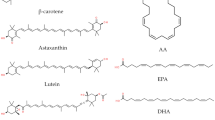A unicellular microalga, Chlorella vulgaris, was isolated from rice field and applied in the biotransformation experiment of hydrocortisone (1). This strain has not been previously tested for hydrocortisone bioconversion. Fermentation was carried out in BG-11 medium supplemented with 0.05% substrate at 25°C for 14 days incubation. The products obtained were chromatographically purified followed by their characterization using spectroscopic methods. 11β,17α,20β,21-Tetrahydroxypregn-4-en-3-one (2), 11β,17β-dihydroxyandrost-4-en-3-one (3), and 11β-hydroxyandrost-4-ene-3,17-dione (4) were the main bioproducts in the hydrocortisone bioconversion. Bioreaction characteristics observed were 20-ketone reduction for accumulation of compound 2 and side chain degradation of the substrate to prepare compounds 3 and 4. Time course study showed the accumulation of the product 2 from the second day of the fermentation and 3 as well as 4 from the third day. All the metabolites reached their maximum concentration in seven days. Microalgal 18S rRNA gene was also amplified by PCR. PCR products were sequenced to confirm their authenticity as 18S rRNA gene of microalgae. The result of PCR blasted with other sequenced microalgae in NCBI showed 100% homology to the 18S small subunit rRNA of six strains of Chlorella vulgaris.
Similar content being viewed by others
References
Y. Ghasemi, M. Tabatabaei Yazdi, A. Shafiee, M. Amini, Sh. Shokravi, and G. Zarrini, Pharm. Biol., 42, 318 (2004).
Y. Ghasemi, M. Tabatabaei Yazdi, A. Dehshahri, H. Niknahad, Sh. Shokravi, M. Amini, A. Ghasemian,and M. A. Faramarzi, Chem. Nat. Comp., 42, 702 (2006).
M. Tabatabaei Yazdi, H. Arabi, M. A. Faramarzi, Y. Ghasemi, M. Amini, Sh. Shokravi, and F. Aziz Mohseni,Phytochemistry, 65, 2205 (2004).
M. Tabatabaei Yazdi, Y. Ghasemi, A. Ghasemian, Sh. Shokravi, H. Niknahad, M. Amini, A. Dehshahri,and M. A. Faramarzi, World. J. Microbiol. Biotechnol., 21, 811 (2005).
A. Pollio, G. Pinto, M. Della Greca, A. D. Maio, A. Fiorentino, and L. Previtera, Phytochemistry, 37, 1269 (1994).
A. Pollio, G. Pinto, M. Della Greca, A. Fiorentino, and L. Previtera, Phytochemistry, 42, 685 (1996).
Y. Ghasemi, S. Rasoul-Amini, M. H. Morowvat, S. B. Mosavi Azam, S. Shokravi, A. Mohagheghzadeh, M. B. Ghoshoon, and M. J. Raee, Biotechnology, 7 (2), 293 (2008).
K. M. Lai, M. D. Scrimshaw, and J. N. Lester, Appl. Environ. Microbiol., 68, 859 (2002).
M. A. Faramarzi, M. Tabatabaei Yazdi, A. Shafiee, and G. Zarrini, Steroids, 67, 869 (2002).
Z. Moradpour, M. Torshabi, M. A. Faramarzi, M. Tabatabaei Yazdi, Y. Ghasemi, H. Jahandar, N. Zolfaghary, and G. Zarrini, Res. J. Microbiol., 1, 289 (2006).
D. N. Kirk, H. C. Toms, C. Douglas, and K. A. White, J. Chem. Soc., Perkin Trans. II, 9, 1567 (1990).
S. J. Todd, R. B. Cain, and S. Schmidt, Biodegradation, 13, 229 (2002).
K. Itoh, H. Sakamaki, K. Nakamura, and A. Horiuchi, Tetrahedron Asymmetry, 16, 1403 (2005).
Y. J. Abul-Hajj and X. Qian, J. Nat. Prod., 48, 244 (1986).
L. L. Smith, Steroids, in: H. J. Rehm and G. Reed, eds., Biotechnology, Vol. 6a, Weinheim, Verlag Chemic GmbH, 1984, pp. 31–78.
M. M. Allen, J. Appl. Phycol., 4, 1 (1968).
G. W. Prescott, Algae of the Western Great Lake Areas, W.M.C. Brown Company Publisher, Dubuque, Iowa, 1962.
D. M. John, B. A. Whitton, and A. J. Brook, The Freshwater Algal Flora of the British Isles, an Identification Guide to Freshwater and Terrestrial Algae, Cambridge, Cambridge University Press, 2003, pp. 39–43.
R. A. Andersen, Algal Culturing Techniques, Elsevier Academic Press, 2005, pp. 239–287.
Acknowledgment
This work was supported by a grant from the Research Council of Shiraz University of Medical Sciences, Shiraz University of Medical Sciences, Shiraz, Iran.
Author information
Authors and Affiliations
Corresponding author
Additional information
Published in Khimiya Prirodnykh Soedinenii, No. 6, pp. 691– 694, November–December, 2009.
Rights and permissions
About this article
Cite this article
Ghasemi, Y., Rasoul-Amini, S., Hossein Morowvat, M. et al. C-20 ketone reduction of hydrocortisone by rice field microalga Chlorella vulgaris MCCS 013. Chem Nat Compd 45, 824–828 (2009). https://doi.org/10.1007/s10600-010-9496-6
Received:
Published:
Issue Date:
DOI: https://doi.org/10.1007/s10600-010-9496-6




